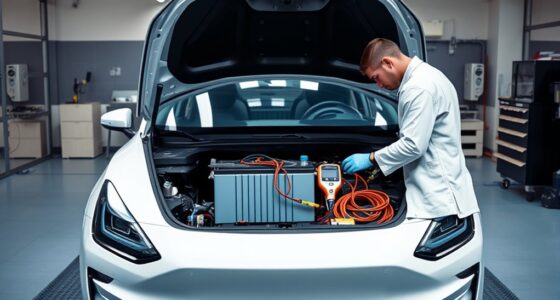Understanding your spark plugs is key to keeping your engine running smoothly. Most copper plugs need replacement every 20,000 miles, while platinum or iridium ones last up to 100,000 miles. Watch for signs like engine misfires, rough idling, difficulty starting, or decreased fuel efficiency—they indicate worn or fouled plugs. Regular checks and timely replacements help avoid costly issues. If you want to learn more about maintaining your spark plugs, keep exploring these important tips.
Key Takeaways
- Replace copper spark plugs every 20,000 miles; platinum or iridium plugs can last up to 100,000 miles.
- Signs of wear include engine misfires, rough idling, difficulty starting, and decreased fuel efficiency.
- Visual deposits or electrode wear on spark plugs indicate they may need replacement.
- Regular inspections help identify early signs of spark plug deterioration before performance issues occur.
- Proper maintenance ensures efficient engine ignition, fuel economy, and reduces emissions.

Have you ever wondered how your car’s engine ignites to keep you moving? It all starts with the ignition system, and at the heart of this process are spark plugs. These small but essential components generate the spark necessary to ignite the air-fuel mixture inside the engine’s cylinders. Without properly functioning spark plugs, your engine struggles to start, runs unevenly, or wastes fuel. That’s why understanding spark plugs is fundamental for maintaining your vehicle’s performance and fuel efficiency. When your spark plugs are in good shape, they guarantee a strong, consistent spark, helping your engine run smoothly and efficiently. Conversely, worn or fouled spark plugs can lead to incomplete combustion, resulting in decreased fuel efficiency and increased emissions.
Your spark plugs don’t last forever. Over time, they accumulate deposits, the electrodes wear down, and their ability to produce a strong spark diminishes. The typical replacement interval for spark plugs depends on the type you have—copper plugs might need changing every 20,000 miles, while platinum or iridium plugs can last up to 100,000 miles. Still, these are general guidelines; your vehicle’s owner’s manual provides the most accurate recommendations. Regular inspections are essential. If your engine starts misfiring, idles roughly, or stalls, it could be a sign that your spark plugs are nearing the end of their lifespan. Other indicators include difficulty starting the engine or a noticeable drop in fuel efficiency. These signs suggest that your spark plugs are no longer firing consistently, which can cause your engine to work harder and consume more fuel.
Replacing spark plugs isn’t complicated, but it’s essential to do it correctly. Before starting, guarantee your engine is cool to avoid burns. Remove the old spark plugs carefully, checking for any damage or excessive deposits that might indicate other engine issues. When installing new plugs, use a torque wrench to tighten them to the manufacturer’s specifications, avoiding over-tightening that could crack the ceramic insulator. Proper gap setting is also critical; if the gap is too wide or too narrow, it can affect spark quality. Using the right type of spark plug for your vehicle maximizes performance and fuel efficiency. Remember, a well-maintained ignition system with clean, properly gapped spark plugs ensures your engine ignites efficiently, saving you money at the pump and prolonging your vehicle’s lifespan. Additionally, understanding the maintenance intervals for jet boats, which often involve specialized engine components, can help you keep your vessel operating smoothly on the water.
Frequently Asked Questions
Can Spark Plugs Improve Overall Engine Performance?
Yes, spark plugs can improve your engine’s performance. When they’re in good condition, they guarantee proper ignition timing, which leads to more efficient combustion. This boosts power, smooths acceleration, and can even improve fuel economy. If your spark plugs are worn or dirty, replacing them helps restore peak combustion efficiency, giving your engine the performance you want. Regular maintenance keeps your engine running smoothly and efficiently.
Are Platinum or Iridium Spark Plugs More Durable?
Imagine a sturdy, long-lasting bridge—platinum spark plugs outshine iridium in durability comparison. Made from premium spark plug materials, platinum offers excellent longevity and resistance to wear, making it ideal for many vehicles. Iridium, while still durable, tends to be slightly less long-lived but provides superior performance in high-demand conditions. So, if you’re after durability, platinum spark plugs are your best bet for extended service intervals.
How Does Fuel Quality Affect Spark Plug Lifespan?
Fuel quality impacts your spark plug lifespan considerably. Poor fuel quality introduces contaminants like dirt, water, and deposits that can foul or damage the plugs faster. Using high-quality fuel reduces these contaminants, helping your spark plugs burn cleaner and last longer. When fuel quality drops, expect more frequent replacements and potential misfires. Always choose good fuel and consider fuel additives to minimize contaminants and extend your spark plugs’ durability.
Are There Specific Signs of Misfiring Related to Spark Plugs?
Your engine’s misfiring is like a chaotic symphony gone wrong, and spark plug issues could be the culprit. Signs of misfiring include rough idling, hesitation during acceleration, and engine warning lights. You might also notice decreased fuel efficiency. These symptoms directly point to ignition system problems, often caused by worn or fouled spark plugs. Catching these signs early keeps your engine running smoothly and prevents costly repairs.
What Tools Are Needed for Spark Plug Replacement?
To replace your spark plugs, you’ll need a spark plug socket and a torque wrench. The spark plug socket fits snugly over the spark plug and often has a rubber insert to protect the ceramic. Use the torque wrench to tighten the new plugs to the manufacturer’s specified torque, ensuring proper installation without over-tightening. These tools make the process easier and help prevent damage to your engine components.
Conclusion
Regularly checking your spark plugs can boost your engine’s performance and fuel efficiency. Did you know that a worn spark plug can reduce your car’s gas mileage by up to 30%? By paying attention to signs like misfires, rough idling, or difficulty starting, you can catch issues early. Stay proactive with maintenance, replace your spark plugs as recommended, and keep your engine running smoothly for years to come. It’s a simple step that makes a big difference!









